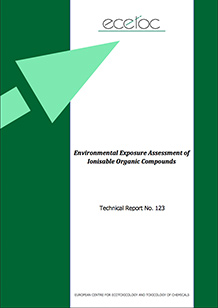TR 123 – Environmental risk assessment of ionisable compounds
READ ONLINESCIENCE NEWS FLASH:
New ECETOC report addresses environmental
exposure assessment of ionisable organic compounds
When predicting the concentration of an ionisable chemical in the environment (an important step in risk assessment), it should be realised that the compound may have different key properties (acidity, partitioning and sorption) depending on pH, ionic strength, etc. While focusing on ionisable organic chemicals, particularly pharmaceutical ingredients and agrochemicals, this report explains the difficulties in applying current international standard methods (OECD test guidelines). Only hydrolysis and biodegradation can be measured as usual. Alternatively, if no measurement exists, the key data can be obtained mathematically, based on structural similarity. This works better for ionisable acids than for bases. Computerised ?chemical space? models can show the chemical's distribution into the environment (partitioning) at different acidities (pH values).
The report makes specific recommendations to take ionisability into account when measuring or estimating the acidity, sorption and partitioning. This should lead to more accurate prediction of environmental (wastewater effluent) concentrations and proper categorisation of ionisable chemicals before they are designated accumulative in environmental organisms or persistent in the environment.
SUMMARY
This report seeks to improve the capability to estimate the bioavailability of ionisable organic compounds, and explores how this information could be used to derive more accurate environmental concentrations for use in assessing environmental risk. The report provides guidance on the analytical methods needed to measure key substance property data with respect to their applicability to ionisable compounds. Existing standard methods to determine acidity, partitioning and sorption were not always appropriate for ionisable compounds, while the methods for hydrolysis and biodegradation could be used for ionisable compounds without limitations. The report also reviews tools (computational methods) used to estimate those data. Some of the estimates based on quantitative structure activity relationships were more accurate when compared to a quality-assured database of 81 active pharmaceutical ingredients, compiled for the purpose.
Additionally, an investigation was made of the use of multimedia models to predict the environmental concentration of an ionisable organic compound. It is demonstrated how, at a low-tier (pre-screening) level, environmental behaviour can be assessed beginning with an evaluation of the 'chemical space' of the equilibrium partitioning of ionisable organic compounds at different acidities (pH values).
There remains a paucity of data directed at improving the mechanistic understanding of sorption, which is critical for improving the understanding of bioavailability and potential for bioconcentration and bioaccumulation. It would thus be prudent to focus future research needs on the development of improved mechanistic understanding. Comparable experiences and needs pertaining to the environmental fate and behaviour of ionisable organic compounds have been encountered by the agrochemicals industry, as summarised in an additional chapter of this report.
In summary, the Task Force recommends that the environmental risk assessment of ionisable organic compounds emphasise a need for projecting robust and reliable estimates and/or measurements of bioavailability. Specifically:
· Testing strategies, particularly those aimed at quantifying the octanol-water partition coefficient KOW, distribution ratio DOW and octanol-carbon partition coefficient KOC, need to ensure that they account for the potential for ionisation during the test, and the implications of ionisation with respect to modelling Clocalwater within the EU TGD framework are appropriately captured.
· With regard to analytical methods, the finalisation of OECD test guideline 122 for measuring the acid dissociation (pKa), KOW and DOW is encouraged.
· The use of quantitative structure activity relationships to estimate KOW, DOW, and KOC need to be checked for their applicability towards the chemical under investigation. Based on observations from data scrutinised within this report, greater confidence in estimation methods appears to be warranted for acids than for bases.
· It is recommended that users compare output from more than one estimation method, for instance between SPARC and ACD with respect to estimates of DOW.
· There is a need for a wider debate regarding the relevance of regulatory triggers, such as KOW, in screening ionisable organic chemicals for their potential to be persistent and bioaccumulative.
· Are there surrogates, other than octanol, that could be better used as a metric for bioaccumulation.
Given the recent interest in ionisable organic compounds, such as those used as APIs, it is of great importance to improve mechanistic understanding of their sorption to various environmental matrices. Research is thus needed to transition the current understanding, which is largely based on interactions associated with neutral organic compounds with organic carbon, to an improved framework for assessing the electronic interactions of a charged molecule with charged solid surfaces. In particular:
· Encourage updates to environmental risk assessment tools, such as SimpleBox and SimpleTreat, to better project concentrations of ionisable organic compounds.
· To complement knowledge gained towards an improved assessment of exposure, there is a need to encourage support to address the relevance of ecotoxicological testing strategies for ionisable organic compounds.

